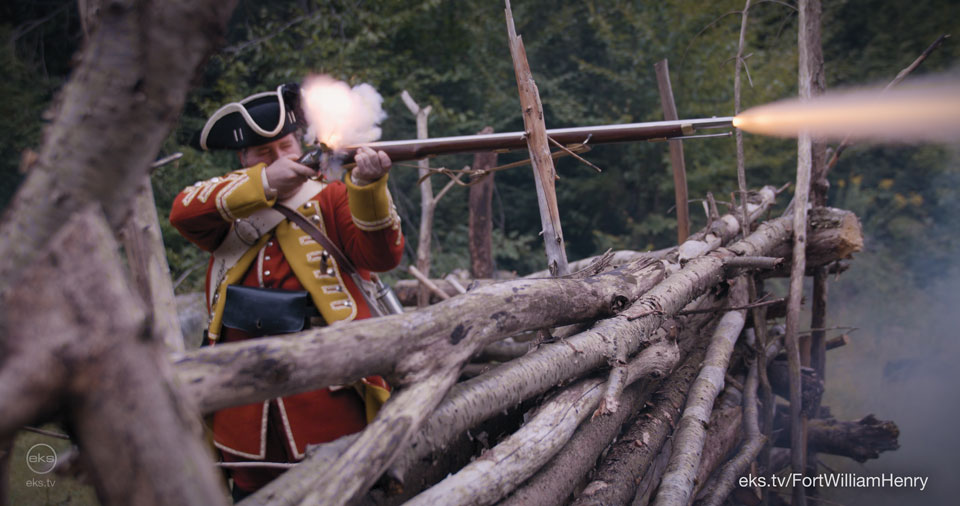The Siege of Fort William Henry
Fort William Henry was a British fort on Lake George, in the New York frontier, during the French and Indian War. In 1757 a French army of 9,000 men, including almost 2,000 of their American Indian allies, laid siege to the fort. Over several days the French cannons bombarded the fort, while the Indians harassed the men in the adjacent encampment.
After 6 days the siege came to an end. The British and colonials in the Fort and adjacent encampment flew the white flag and surrendered.
The following day the Indians attacked the surrendered British troops in what has become an infamous massacre. These events inspired author James Fenimore Cooper to write “the Last of the Mohicans.” The siege of Fort William Henry being the backdrop to his novel.
A Brief Timeline of the Siege
August 3, 1757
The French army traveled South up Lake George toward Fort William Henry. As the French flotilla landed a few miles north of the fort, their Indian allies surrounded the encampment to the Southeast – cutting off communication with Fort Edward, 16 miles to the South.
As the Indians engaged the English, the French army began work on their siege trenches
August 4, 1757
The Indians kept the English pinned down in both Fort William Henry, and the encampment. The men in the fort and camp kept a constant fire on the enemy, causing one of their mortars to burst
At Fort Edward to the South, General Webb began sending letters to neighboring colonies asking for reinforcements. He also sent a letter to Colonel Monro, at Lake George. This letter would not reach Fort William Henry for several days. Webb’s couriers were intercepted on the road from Fort Edward.
August 5, 1757
Hundreds of French troops worked through the night on the siege trenches, the first battery and a communication trench for the second battery.
The Indians kept up there musket fire, with many entering the cleared area around Fort William Henry. The men in the fort returned fire and suffered the loss of more cannons.
August 6, 1757
At 6 in the morning the French cannons began firing on Fort William Henry. They found their mark quickly killing and wounding many in the English fort and camp. One of the cannon balls carried away the pulley of the flagstaff, causing the British flag to fall.
As the French bombarded the fort, the English returned fire, and suffered the loss of several more cannons.
August 7, 1757
In the morning the French flew a flag of truce. They asked for the surrender of the fort and delivered General Webb’s letter that was intercepted on the 4th.
Colonel Monro and his men held fast and continued to defend the fort.
August 8, 1757
The situation of Fort William Henry grew steadily worse. By this morning the French had advanced their trenches across a small marsh toward the fort’s garden
The British and provincials fought on the best they could. At night they sent an engineer to examine the condition of the fort.
August 9, 1757
In the morning, the English called a council of war with all the officers of the fort and camp. They evaluated the state of Fort William Henry and the artillery.
At seven in the morning the fort raised the white flag.
The articles of capitulation were drawn up and the terms were agreed upon by the French and the English.
August 10, 1757
In the morning, the British troops prepared to march to Fort Edward, as agreed upon in the articles of capitulation.
The French allied Indians began to surround the encampment and strip the British of their belongings. They had been promised the spoils of war for their participation in this campaign, and were determined to take them.
The march from the encampment quickly turned into chaos, with the British and provincials fleeing in all directions as the Indians attacked the column of men.
The Documentary of the Siege of Fort William Henry
“The Last of the Mohicans” has by far become the most well known telling of the story of Fort William Henry. That story, combined with other 19th century novels and literature have given people fictional and sensationalized versions of the events. This documentary aims to change that, relying extensively on historic documents to build the story.
Journals Tell the Story
For this documentary I mined the journals and letters of men who were at the Siege.
A report from Colonel Joseph Frye, the Journals of the French General Montcalm, his aide de camp, and many others bring the historic events to life.
Hear the story from men on both sides of the Siege of Fort William Henry.
About the Documentary



